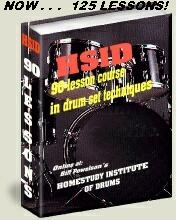In the early days of this course, this was once a form the student filled-out and submitted. As a free service I would analyze the input, then e-mail a specific set of lessons that each individual student should pursue, depending on their level of ability. It was a great service, but now there isn't anyone available to do the assessments for you. However, I have a prepared response that sufficed in 90% of the cases. What follows here, is the most likely response you would have probably received.
Hopefully, this little pep talk will encourage you to follow the most direct path of lessons leading to your speediest success at the drum set . . .
THE BASIC DANCEBEATS . . .
The basic beats are really the WHOLE BALL OF WAX! Many long-time, working pro-drummers do not know this . . . but it's true . . . You'll come to realize it too . . . over-time, as you play along with more and more music.
Memorize ALL those basic beats . . . push them ALL to the limit (tempo wise), as you do your routine jams . . . Just bang on anything if you aren't behind a drumset. Get into the flow of the music . . .
Keep doing those routine jams . . . Jam with all your fav recordings . . . relate ALL the music you hear, to those basic beats . . . You'll be using all of them (and more), as you try to play along with ALL the music that's out there.
You'll get to where you can hear those patterns instinctively as any song begins to play . . . AND by the 2nd, 3rd or 4th bar of the song . . . you'll be playing along . . . even though it may be the first time you've ever heard the song in your life.
This is the way we operate onstage! It OFTEN occurs onstage, that a song will come up that we've NEVER heard before. This system of Basic Dance Beats will come to the rescue every time.
With those beats . . . you'll gain the ability to 'feel' your way into ANY song quickly and 'naturally'. This is the way all 'NATURAL' drummers do it, whether they know the theory and notation or not. Many times, the 'natural' drummer may not know the name of the basic pattern he's playing . . . but he'll be playing it, just the same. (It's a math thing.) The 'gear ratios' are numerical . . . and that's that! We can study it . . . and see it visually . . . or we can grope in the dark for 20 years by 'feel' . . . before we realize it. The numbers don't lie and they ARE there whether we see them or not.
Visually inspect all the basic beats . . . slowest to fastest . . .
See the way the cymbal notes are ordered from the top beat (16th rock) down to the bottom (4th rock), . . . 4 + 4, 3 + 3, 2 + 2, and 1 + 1. Dancebeat #4 seems to upset the theory . . . but in reality . . . it DOES fit into the tempo patterns . . . and it's a VERY common . . . BASIC beat structure.
READING NOTATION . . .
DON'T be overly concerned about the sight-reading thing. The course is stair-stepped in a way that will (hopefully) have you reading like an old-timer by the time you finish the lessons.
THE BEST WAY TO STUDY THE COURSE . . .
- MEMORIZE all the Basic Dance Beats first . . .
- Begin jamming with recordings asap (I know you are already doing this.) Keep at that, ALWAYS . . .
- You may want to get into the standardized fills at "Rudiments, Rolls & Fills" . . . Study them and try to pick up on the idea of 'HALF BAR' fills, beginning here:
Half Bar fills: Just follow the links at the bottom of each lesson, to the next lesson. Take each lesson, one-at-a-time, very slowly. As you study any of the lessons. Get the basic idea, then put on a medium tempo 8th rock song, and try to do what you have learned in the lesson. Technically, you can place fills of any length, anywhere you choose, inside of any song. You do NOT need to copy the recorded drummer unless you wish to make such a rule. Such a rule does NOT exist in music theory. People often impose rules that do NOT exist. Don't fall victim to that sort if thinking. Keep your creative channels open. It's important! I always strive to out-play the drummer on the recording. What could be wrong with that idea?
AD-LIB YOUR OWN FILLS!
We can do ANYTHING as a fill. We needn't do those specific standard fills. It's BETTER to just use your own 'good ear' and creative imagination. Play what you feel . . . try to do things that fit the music you are playing . . . Listen to the fills on the recordings and do something similar (if you wish), or do anything you like.
There's really only one rule.
"STAY IN-TIME WITH THE MUSIC!"
As you emerge from a fill . . . be certain that you are still connected in-time with the song. Your BACKBEAT FLOW should still match theBACKBEAT FLOW of the song.
The Standard Fills are good for developing coordination. They're good for getting the 'chops' (hands and feet) up to speed . . . but there's nothing better than the ad-lib, improvised fills that come from within your own spirit and imagination.
Just let it flow . . . and ALWAYS strive to stay in-time with the drummers on the recordings.
Once you've completely conquered the basic beats and the basics of fills . . . you can randomly JUMP AROUND within the course without too much confusion. I think it's best to do that. Study what you are 'into' at the time you are 'into' it. That's exactly the way I teach all this in the private classes. First, I figure out what the student is most interested in . . . then we study that! Each week, we do a new and different lesson . . . but we are ALWAYS trying to target the students goals and interests. It's sorta hard to shove 'Waltz Beats' down a students throat . . . if all their CDs are blasting away with blazing-fast, 8th and 4th rock.
HAVE A BALL with all this! The ability you are seeking will come from PLAYING THE MUSIC itself! The more you jam, the more I can guarantee the lessons will be fruitful and productive.
I'm an old seat-of-the-pants (ear) drummer myself. All these lessons have been taken directly from bandstand experience with the 1,000+ bands I've worked with over the years . . . This is the stuff you'll need in your heart, mind, and soul, as you get with a band and play 'off-the-top of your head', as we tend to do 99% of the time.
Memorize ALL the basic beats first. They're here:
ADVANCED LESSONS . . .
After memorizing those, here are a couple of more advanced lessons . . .
Master 16th rock . . .
There are 4.3 billion possible variations, of this pattern, but if you can confidently play 20 to 30 of them, you will soon learn to love playing all songs that fall into this very important beat structure.
ADDITIONAL LESSONS: For the more advanced students.
This lesson below, is designed to help get you smoking even hotter with 8th rock . . . Don't be happy until you can play ALL these in your sleep. The bass syncs in the middle of the lesson are VERY difficult. Once you can repeat each of them comfortably at rapid tempos, your playing will go ballistic. There's a LOT of work, here . . .
8th 4/4 (rock) variations and bass syncopations.
Have fun!
For every 15 minutes of study with the lessons, you should jam with recordings for an hour or more. This formula will have you kickin' mo butt, in just a few weeks.
Your measure of yourself is VERY IMPORTANT! How do you measure up as a person? This may offer a clue!
Finite To Infinity
3 very important questions
IS IT POSSIBLE THAT YOUR 'NATURAL GIFT' OF RHYTHM CAN BE DOUBLED WITH ONLY A LITTLE ADDITIONAL (PREVIOUSLY UNAVAILABLE), KNOWLEDGE?
IS THERE A 'KNOWLEDGE GAP' IN YOUR OWN UNDERSTANDING OF 'RHYTHM'?
IS IT POSSIBLE TO GAIN A COMPLETE AND THOROUGH UNDERSTANDING OF 'ALL RHYTHM', WITHIN ONLY A COUPLE HOURS OF EASY, AND FASCINATING, STUDY ?
Answers: YES! YES! YES!
Get All Products Here

GET ALL THE PRODUCTS AT ONE LOW PRICE.
SURPRISES ABOUND!!!! . . . For those with a bit of generosity in their soul.
CLICK HERE , to see what I mean.
Intermediate & Advanced Drummers
- Drum Instructors Wanted
- Teach My Lessons and Methods
- Up to $60.00/hour
Pre-School Drummer?
Can we teach rhythm to pre-schoolers? YES!
This is a very short course, designed to help adults plant the seeds of rhythm into children of nearly any age. Click Here!!
Make CASH $$$ Now!!!

FREE ELECTRONIC BOOK BONUS (also included) BUSINESS OPPORTUNITY:
- * MAKE BIG MONEY SELLING USED DRUMSETS!
- * INSIDER HARDBALL-BUYING-TIPS AND SECRETS.
- * UNIQUE RECOVERING SECRETS
Support Us Today!!
Support this site and and gain an advetising bargain with the deal. Place a permanent ad here.
